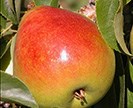Modeling Nutrient Loss from Midwest Crop Fields
A new pear cultivar called “Gem” has been released by the U.S. Department of Agriculture (USDA), Oregon State University, Michigan State University, and Clemson University.
Agricultural Research Service horticulturist Richard Bell at the ARS Appalachian Fruit Research Station in Kearneysville, West Virginia, and his colleagues consider Gem to be ideal for the fresh market, combining high yields with excellent appearance, fruit quality, and storage potential.
“This cultivar ripens a week to 10 days after Bartlett and before Bosc and Anjou,” says Bell. “Gem has a sweet flavor and can have a nice red blush to the skin.” When comparing Gem to Bartlett—a popular pear variety—sensory panelists rated it similar in appearance, flavor, and purchase intent.
Gem has other advantages, too. The new cultivar is resistant to fire blight and isn’t prone to the brown discoloration, called “superficial scald,” that affects some pear varieties.
“The source of Gem’s fire blight resistance is the cultivar Barseck,” says Bell. “Subsequently, Gem was evaluated for fruit quality, fire blight resistance, and productivity in replicated trials at the ARS Kearneysville location and at the research centers of Washington State University, Oregon State University, Michigan State University, and Clemson University.”
Gem can be harvested over a 3-week period. It is unique in that it can be eaten at harvest, when the flesh is crisp. It requires at least 3 weeks of cold storage before normal fruit softening, and it will last for at least 28 weeks in cold storage without core breakdown or superficial scald. “In common air storage, it can stay edible for 5 months,” says Bell.
Gem will be recommended as a fresh-market pear for both commercial and home growers.
The cultivar is currently going through the process of being certified as virus free via the National Clean Plant Network (NCPN), which requires repeated negative tests for a number of viruses. The NCPN is a voluntary association of specialty crop networks that collaborate to promote the use of pathogen-tested, healthy plant material for food crops in the United States. The NCPN is operated by three USDA agencies: ARS, the Animal and Plant Health Inspection Service, and the National Institute of Food and Agriculture.
While budwood of Gem is limited, genetic material of this release will be deposited in the National Plant Germplasm System, where it will be available for research, development, and commercialization of the new cultivar.—By Sharon Durham, Agricultural Research Service Information Staff.
This research is part of ARS National Program #301, Plant Genetic Resources, Genomics, and Genetic Improvement.
"ARS and Collaborators Produce a Gem of a Pear" was published in the January 2015 issue of Agricultural Research magazine.







